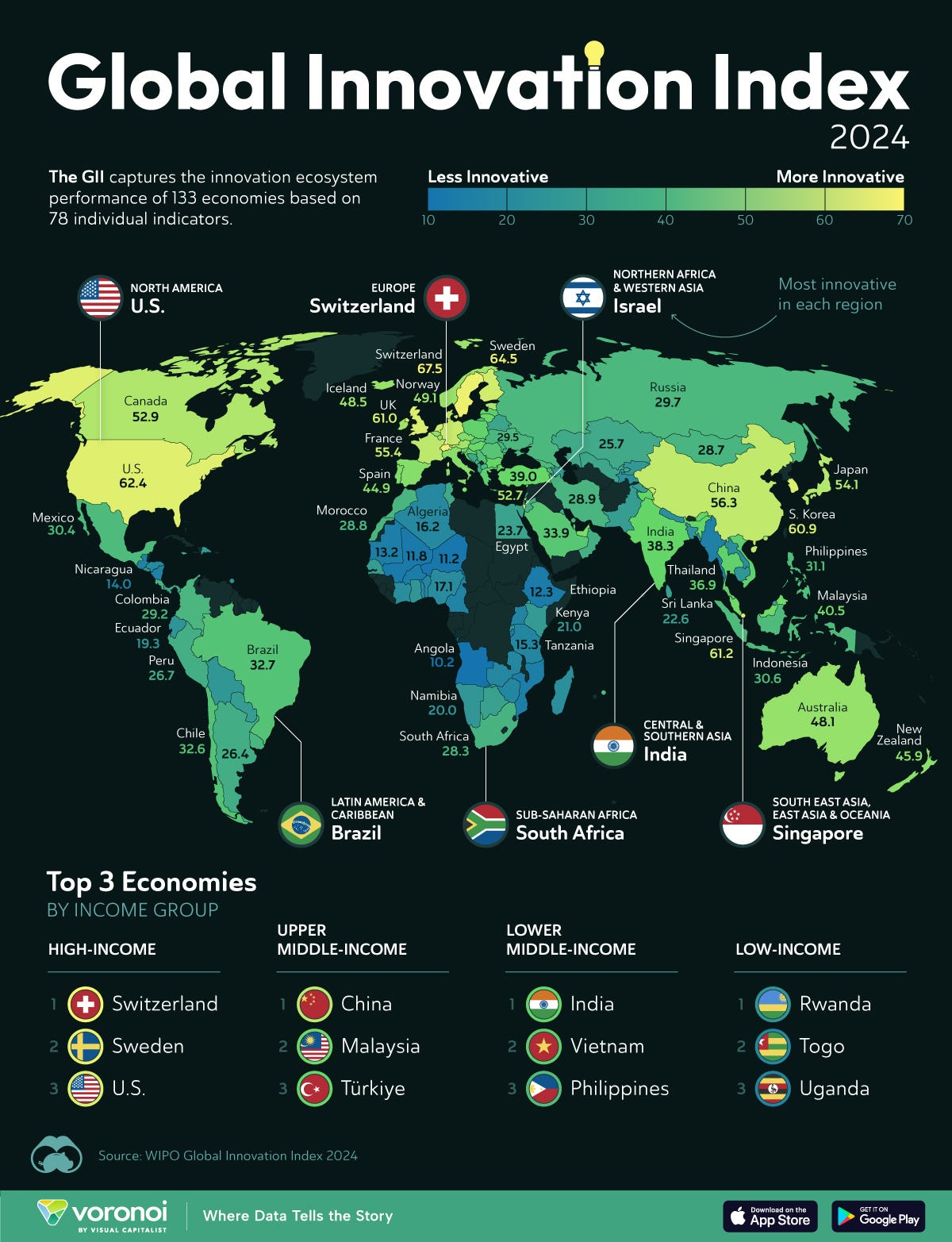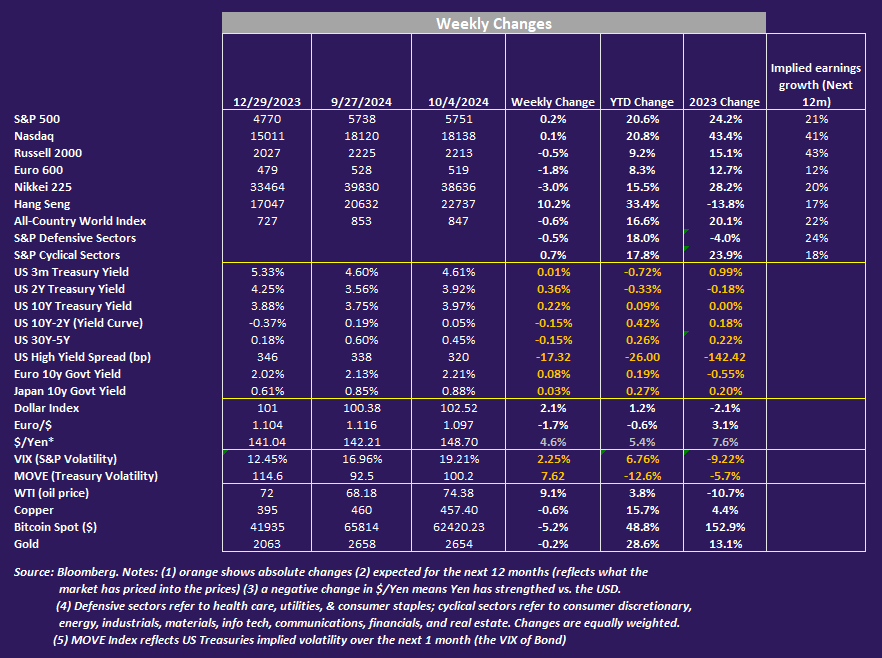Weekly Good Reads: 5-1-1
US Jobs, China Rally, Quality Stocks, Innovation Index, Sovereign Wealth Fund, Google Lens
Welcome to Weekly Good Reads 5-1-1 by Marianne, a 25-year investment practitioner writing about investing, economy, wellness, and something new I learned in AI/productivity.
In this Weekly, I share insightful/essential readings, charts, and one term, incorporating some of my market observations and weekly change tables. I look beyond data and share something enlightening about life, health, technology, and the world around us 🌍!
Here’s the quote of the week:
If you don’t own a piece of a business, you don’t have a path towards financial freedom.
~ Naval Ravikant
Feedback is important to me, so if you like the Weekly, please “heart” it, comment, share it, or subscribe! Thank you so much for your support🙏.
Weeklies archive | Investing | Ideas | Index of charts and terms
Conversations with Female Investors and more (to inspire more females into finance and investment careers 🙌.)
Market and Data Comments
The US September nonfarm payrolls jumped higher than expected to 254k (the 12-month average at 203k and the consensus at 150k), while unemployment fell to 4.1% (from 4.2%). Average hourly earnings rose at a brisk pace of 0.4% m/m (4% yoy).
While commentaries were all over the place about the job reports from “inflation is not dead” and “fake jobs data” to “reinforcing economy’s resilience,” Fed Watch Tools shows the probability of a 25bp rate cut in November FOMC jumped to 97% as of October 5, up from 47% and that of a 50bp cut dropped to 0% from 53% a week ago.
Morgan Stanley’s analyst, to my chuckle, called the jobs report a “random number generator” and found that since 2000, “the actual payroll print came outside of the estimate range 29% of the time”, and “even when the payroll print comes inside the estimate range, it still misses badly almost 1/3rd of the time”, while “over the past 2 years, 75% of payroll prints came above consensus.”
Based on the continuing contractionary manufacturing PMI (albeit services PMI rose most rapidly), the job openings rate declining to the 2019 level, hiring and the quits rate at the worst levels in 10 years, the outsized September jobs number mainly represents a US soft landing and likely as the Moody’s chief economist said, “this economy is as good as it gets.” Worth watching is the continued GDP weakness in the Euro Area led by Germany, pointing to another rate cut in October.
As Barclays highlighted in its latest Global Economic Weekly, the first nine months of 2024 have been calm, economy-wise. However, we have entered a critical Q4, with the US election uncertainty (winner too close to call), China’s stimulus execution, the Fed’s easing path, heightened geopolitical risks (this past week with Israel-Iran), and trade and tariffs tensions leading to very different economic outcomes — increase in aggregate demand coupled with sudden supply shock (e.g. oil), softening aggregate demand with easing supply shocks, or combinations in between.
Market-wise, the jump in oil prices (+9.1%), US 2-year yield (+36bp to 3.92%), US 10-year yield (+22bp to 3.97%), and Hong Kong stocks (+10.2% propelled by Chinese stimulus policy) caught investor’s attention during this past week.
In China, Goldman pointed out that the stock index (measured by MSCI China) has had many false starts during the bear trend in the past four years. Nevertheless, on a price-multiple basis, stocks are at or near their ten-year low while mutual funds’ allocation to Chinese equities is at the lowest (5%) in the last decade.
, an influential Wall Street economist, highlighted China needs a “Three Arrows Strategy” (aka Japan) where monetary and fiscal policies and structural reforms work together to turn around its economic decline and put it on sustainable recovery.From Goldman Sachs: If China does carry through its fiscal stimulus (watch the October policy meeting), beneficiaries will include Hong Kong stocks, retail and insurance, metals and mining as well as real estate, internet/media, and energy.
This coming week we will monitor the US September FOMC meeting minutes on Wednesday, September CPI on Thursday, PPI on Friday, Germany’s August factory orders on Monday, August nominal wage growth in Japan on Tuesday, and China’s September Total Social Financing and consumer/travel statistics after China returns from the Golden Week.
Economy and Investments (Links):
Fed’s Powell Says Rate Cuts Can Sustain Soft Landing, but Sees No Need to Rush (WSJ or via Archive)
The House-Price Supercycle is Just Getting Going (The Economist or via Archive)
Over the coming years housing markets could face all sorts of slings and arrows, from swings in economic growth and interest rates to banking busts. But with the long-term effects of demography, urban economics and infrastructure aligning, consider a prediction made in 2017 by Messrs Miles and Sefton. It finds that “in many countries it is plausible that house prices could now persistently rise faster than incomes”. The world’s biggest asset class is likely to get ever bigger.
BlackRock Q4 Investment Outlook (BlackRock Investment Institute)
Finance/Wealth (Link):
How To Spot High-Quality Compounder Stocks (Finimize)
Finding a high-quality compounder is just the first step. To make sure your investment is sound, you’ll want to regularly monitor the company to ensure its compounding potential remains intact. This involves checking whether its ROOCE [how efficient is a firm using its capital to generate profits] and gross margins are stable, its pricing power is still strong, and its valuation is reasonable.
Wellness/Idea (Link):
Why Do I Feel Sleepy on the Couch and Then Wide Awake in Bed? (The Washington Post or via Archive)
+ Listening Is an Overlooked Leadership Tool (Harvard Business Review via Archive)
One Chart You Should Not Miss: Which Country is Most Innovative?



Sorry, US folks, the most innovative country is not the US but Switzerland followed by Sweden. The Economist noted that “small countries can outrank scientific superpowers such as America and China because many of the indicators are scaled according to a country’s population or GDP.” 133 countries are ranked on 7 innovation pillars (averaged): knowledge & tech outputs, human capital and research, business sophistication, market sophistication, creative outputs, infrastructure, and institutions.
The innovative trend was however down from 2022.
While a country’s score correlates to its GDP per capita, India and China both stand out as being ranked much higher considering their relatively low GDP per capita vs. their developed market peers.
One Term to Know: Sovereign Wealth Fund
A sovereign wealth fund is a state investment fund with funding coming from different sources such as surpluses from state-owned natural resource revenues, trade, and bank reserves that may accumulate from underspending budget, currency operations, privatizations, and governmental transfer payments.
The purposes of sovereign wealth funds (SWFs) include reducing the volatility of government revenues, countering the boom and bust cycles’ adverse effect on government spending and the economy, and serving as the country’s war chest.
SWFs invest in stocks, bonds, currencies, commodities, and alternatives assets (including private vehicles) with some now directly holding stakes in companies.
The top 100 sovereign wealth funds have assets amounting to $12.8 trillion with the top 8 SWFs by assets as of June 2024 as follows (notice the top SWFs are resource-rich countries except for China and Singapore):
Norway Government Pension Fund Global: $1.76 trillion
China Investment Corporation: $1.33 trillion
SAFE Investment Company: $1.09 trillion
Abu Dhabi Investment Authority: $993 billion
Kuwait Investment Authority: 980 billion
Public Investment Fund of Saudi Arabia: $925 billion
GIC: $800 billion
Qatar Investment Authority: $526 billion
Bloomberg reported that the US government has been preparing for its sovereign wealth fund for months, which can potentially allow “the US to invest in national security interests including technology, energy, and critical links in the supply chain.”
At the least, the two US Parties seem to agree on this one.
While it seems to be a popular government investment strategy, especially for oil-rich countries such as Norway for macro stabilization, SWFs attract growing concerns due to national security issues (investment by foreign SWFs), lack of transparency, and outsized influence on asset markets.
[🌻] Things I Learn About AI/Productivity:
AI: Dystopia or Utopia (Vinod Khosla)
We face choices: accelerate, slow down, or moderate disruptive technologies, and decide whether to compensate those displaced. Change can be painful for the disrupted, and embracing AI's positives requires keeping those affected at the center of policy. These changes pose significant challenges, but they also offer an opportunity to create in the 25+ year windows a more empathetic society and a post-resource-constrained world. This is a luxury that has been unaffordable in the past but may now be ours to use.
Ask Questions in New Ways with AI in Search (Google)
Google has had a slew of announcements about its new AI search tools in voice and visuals, leading me to test out their functionalities. For example, when I want to know what plant it is on the curbside, I just go to the Google Chrome app on my phone and press the “lens” icon in the search bar, then I can snap any picture with an added question in text, and Google will come up with links and images explaining what it is that I need. You can also click on the “Google Lens” on your desktop and highlight any text/images on a webpage. A sidebar will open up on the right to show you the relevant links. Handy, isn’t it?
Please do not hesitate to get in touch if you have any questions!
Please also check out my Conversations with female fund managers, wealth advisors, and more.
If you like this Weekly, please share it with your friends or subscribe to my newsletter🤝.











For the Chinese stimulus to have an impact on the consumer and domestic businesses (ex. Banks and RE companies) gunna take a while to work through the system. Will be interesting to see what happens in the interim. Been pretty messy this year.